U.S. Markets: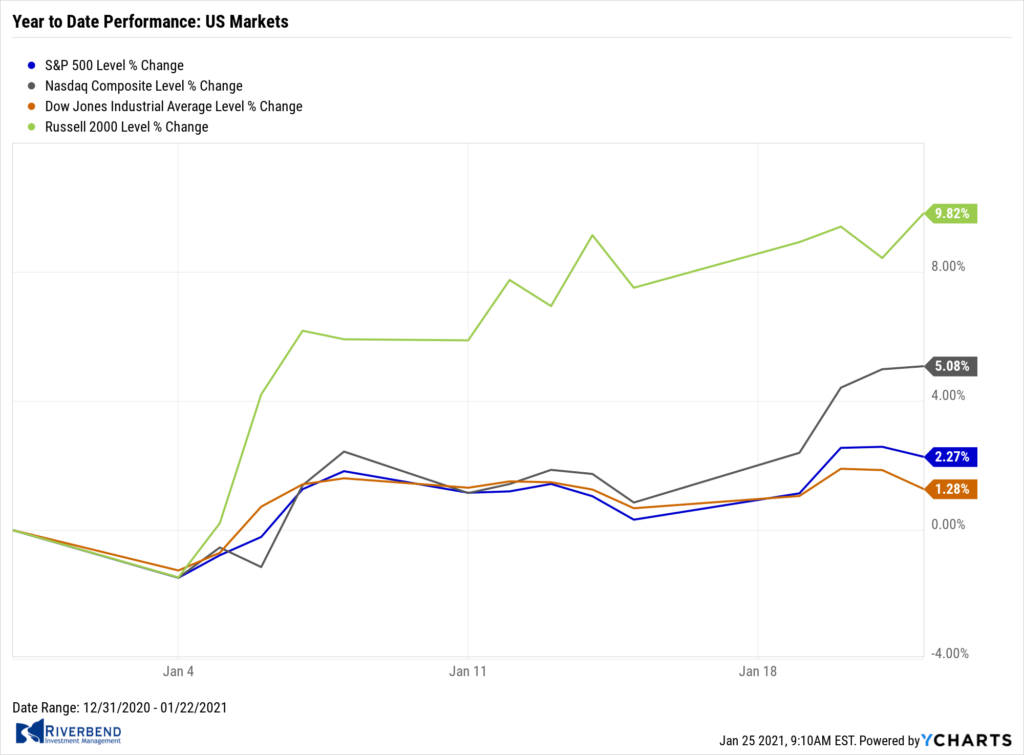
The major indexes moved higher for the week, hitting new intraday highs before a pullback on Friday.
The Dow Jones Industrial Average rose 183 points closing at 30,997 – a gain of 0.6%. The technology-heavy NASDAQ Composite surged 4.2% to 13,543.
By market cap, the large cap S&P 500 rose 1.9%, while the midcap S&P 400 and small cap Russell 2000 added 1.6% and 2.1%, respectively.
International Markets: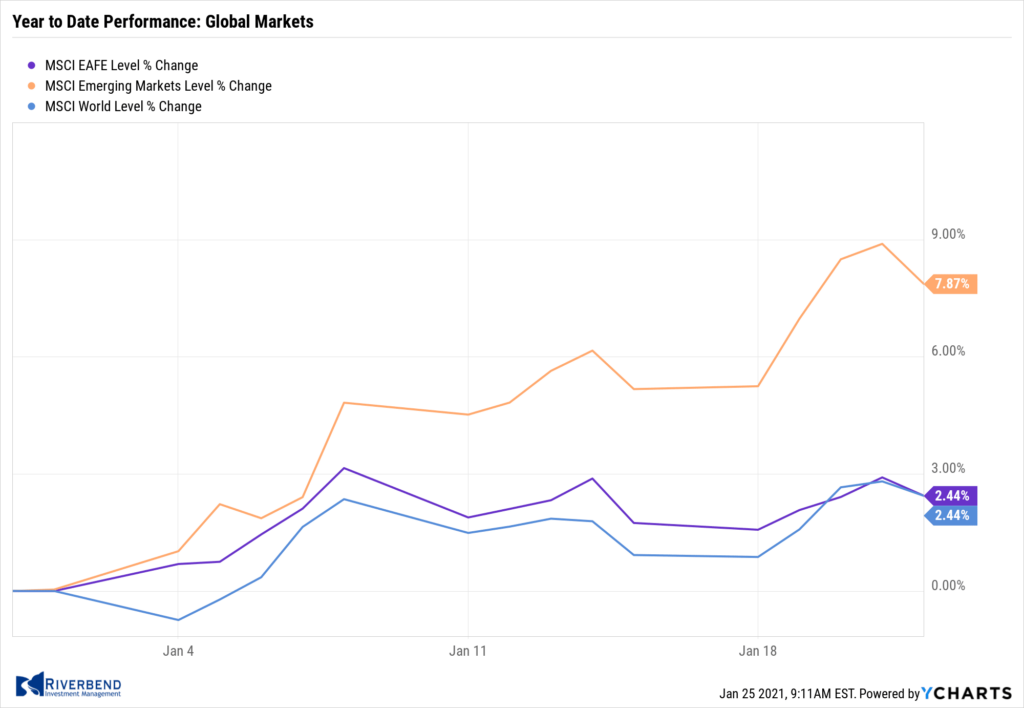
Major international markets finished mixed for the week. Canada’s TSX declined -0.4% along with the United Kingdom’s FTSE which gave up -0.6%.
On Europe’s mainland, France’s CAC 40 declined -0.9% while Germany’s DAX gained 0.6%. In Asia, China’s Shanghai Composite rose 1.1% and Japan’s Nikkei gained 0.4%.
As grouped by Morgan Stanley Capital International, developed markets rose 1% while emerging markets gained 2.7%.
Commodities: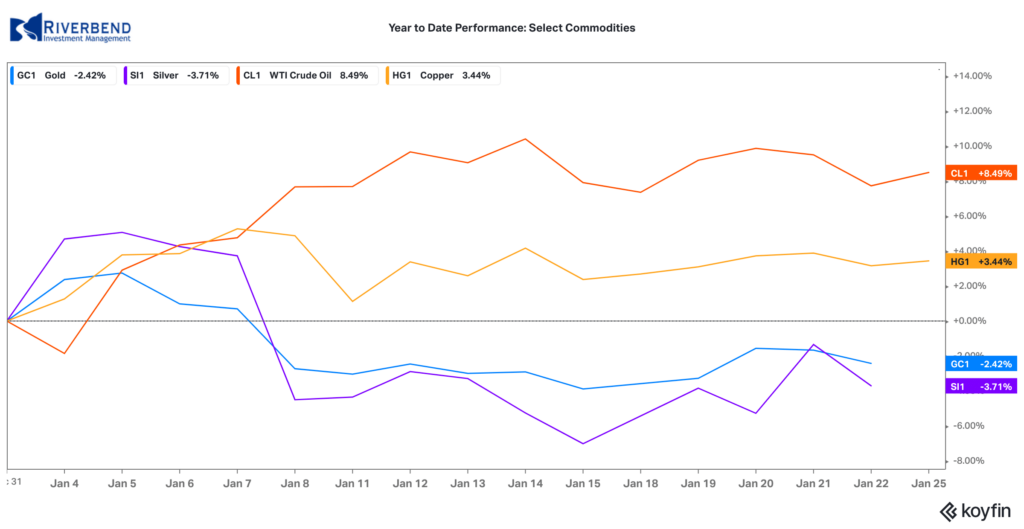
Precious metals rose last week, with gold rising 1.4% to $1856.20 per ounce and silver adding 2.8% to $25.56.
West Texas Intermediate crude oil had its first down week in three declining -0.3% to $52.27 per barrel.
The industrial metal copper, viewed by some as a barometer of world economic health due to its wide variety of uses, ended the week up 0.7%.
U.S. Economic News: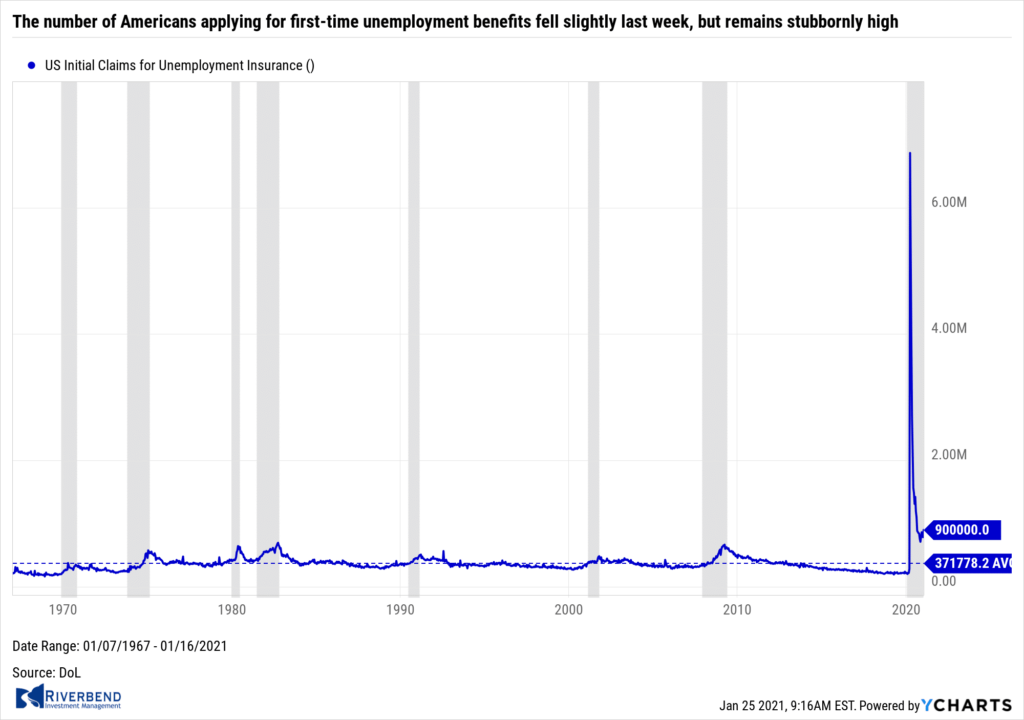
The number of Americans applying for first-time unemployment benefits fell slightly last week, but remained stubbornly high. The Labor Department reported initial jobless claims declined by 26,000 to a seasonally-adjusted 900,000 last week. Economists had expected a reading of 925,000. For perspective, claims had been running in the low 200,000’s just before the pandemic took hold. Continuing claims, which counts the number of people already receiving benefits, declined by 127,000 to 5.18 million. That number is reported with a one-week delay.
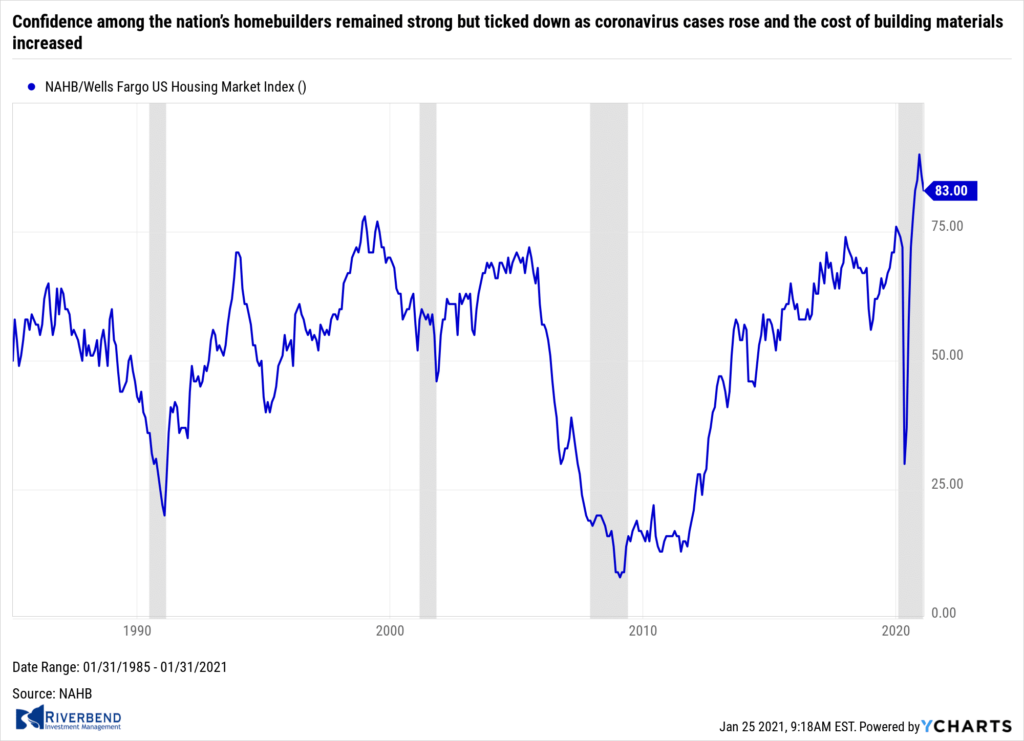 Confidence among the nation’s homebuilders remained strong but ticked down as coronavirus cases rose and the cost of building materials increased. The National Association of Home Builders’ (NAHB) reported its monthly confidence index dropped 3 points to 83 in January. Economists had expected a reading of 85. Still, the index remains far above 50—the dividing line between growth and contraction.
Confidence among the nation’s homebuilders remained strong but ticked down as coronavirus cases rose and the cost of building materials increased. The National Association of Home Builders’ (NAHB) reported its monthly confidence index dropped 3 points to 83 in January. Economists had expected a reading of 85. Still, the index remains far above 50—the dividing line between growth and contraction.
In the details, the index that measures sentiment regarding current sales fell 2 points to 90, while the index of expectations of future sales also declined 2 points to 83. The gauge regarding prospective buyers slipped 5 points to 68. By region, confidence weakened the most in the Northeast, followed by smaller declines in the West and South. Confidence ticked up 2 points in the Midwest.
The Census Bureau reported home builders started construction at a seasonally-adjusted annual rate of 1.67 million in December – a 5.8% increase over November. Furthermore, permitting of new homes, an indicator of future building activity, rose by 4.5%. Both figures came in above analysts’ expectations reflecting growth in the single-family sector. On a monthly basis, single-family starts were up 12%, while single-family permits were up 7.8%. On a regional basis, all parts of the country saw permitting activity increase except for the Northeast, where it fell 7.2%.
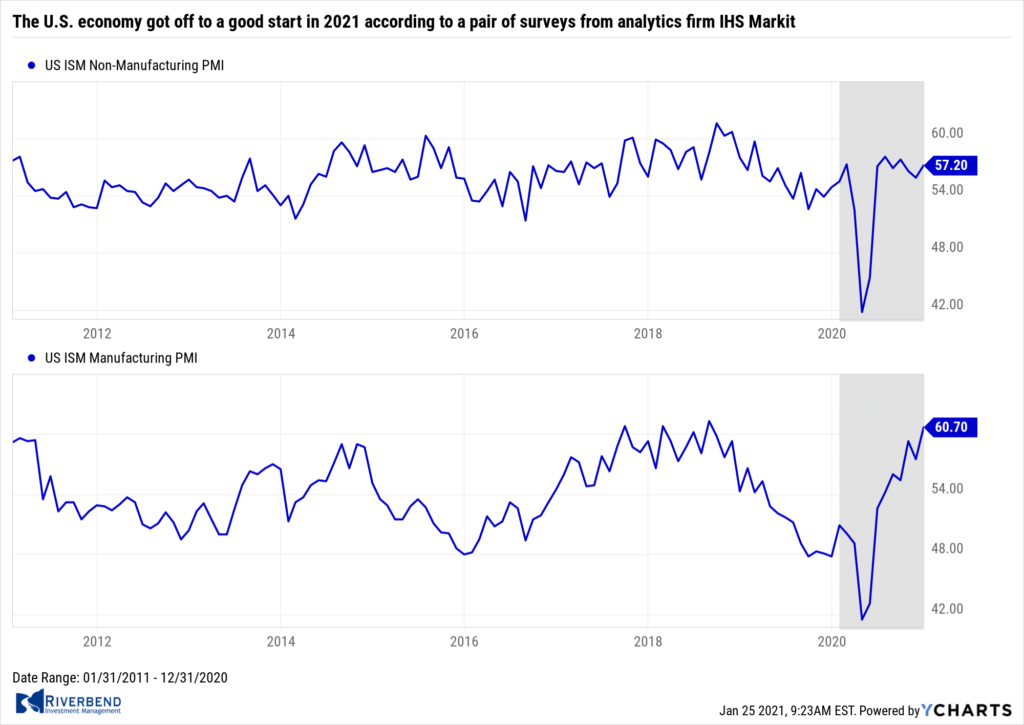 The U.S. economy got off to a good start in 2021 according to a pair of surveys from analytics firm IHS Markit. Markit reported its purchasing managers’ indexes (PMI) for both the services and manufacturing sides of the economy improved this month. The PMI for the much larger services side of the economy rose to a two-month high of 57.5 in January, an increase of 2.7 points. Furthermore, the PMI for the manufacturing side of the economy climbed 2 points to a record 59.1.
The U.S. economy got off to a good start in 2021 according to a pair of surveys from analytics firm IHS Markit. Markit reported its purchasing managers’ indexes (PMI) for both the services and manufacturing sides of the economy improved this month. The PMI for the much larger services side of the economy rose to a two-month high of 57.5 in January, an increase of 2.7 points. Furthermore, the PMI for the manufacturing side of the economy climbed 2 points to a record 59.1.
Of concern, however, was that hiring was especially soft among services companies (which employ more than 80% of America’s workforce). Chris Williamson, chief IHS business economist stated, “U.S. businesses reported a strong start to 2021, buoyed by hopes that vaccine developments will mean the worst of the pandemic is behind us, and that the new administration will provide a stable and supportive environment for stronger economic growth.”
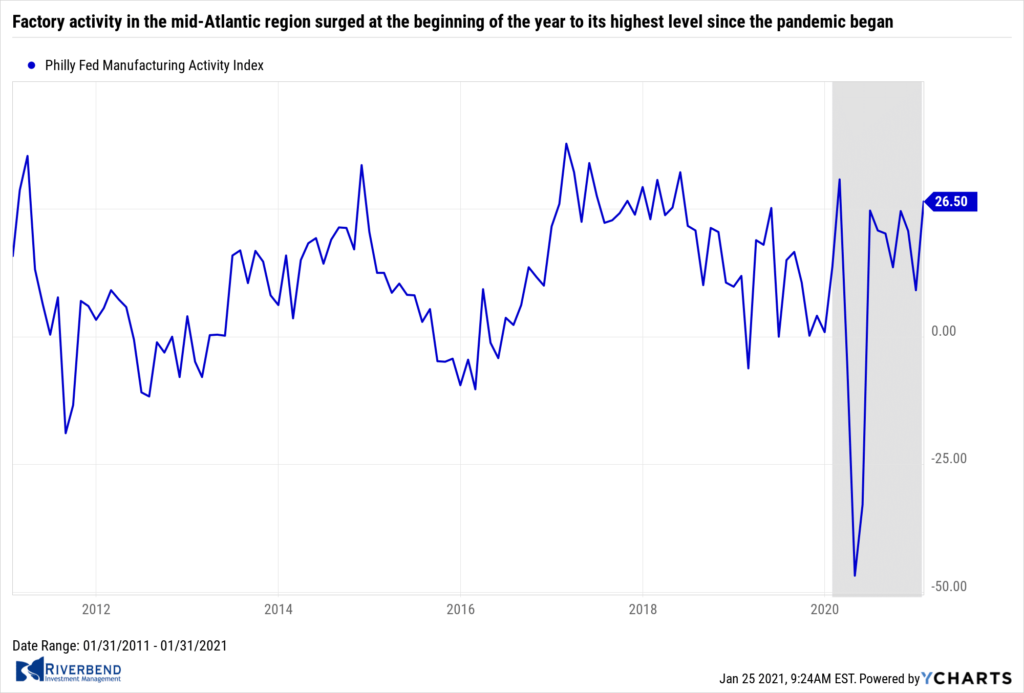 Factory activity in the mid-Atlantic region surged at the beginning of the year to its highest level since the pandemic began, according to data from the Philadelphia Federal Reserve. The Philly Fed reported its business conditions index jumped to 26.5 in January—a 17.4 point increase from December. The reading was far above the consensus forecast of 10.5.
Factory activity in the mid-Atlantic region surged at the beginning of the year to its highest level since the pandemic began, according to data from the Philadelphia Federal Reserve. The Philly Fed reported its business conditions index jumped to 26.5 in January—a 17.4 point increase from December. The reading was far above the consensus forecast of 10.5.
In the details, the six-month outlook rose to 52.8, from 43.1 last month. New orders, employment and shipments all jumped in January. Of concern, there were signs of inflationary pressures in the supply chain. Manufacturing has been a bright spot in the U.S. economy as it’s more insulated from the stringent social distancing guidelines that weigh heavily on the services sector. Oren Klachkin, lead U.S. economist at Oxford Economics wrote in a note, “Looking ahead, manufacturing will stay on an upbeat track though we expect growth to soften as vaccines and the economy’s reopening unleash pent-up demand for deeply-damaged services.”
Chart of the Week: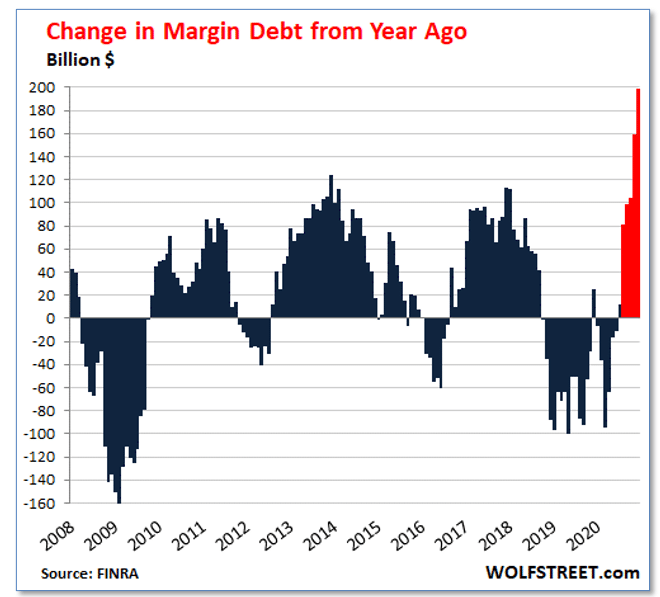
Video game retailer GameStop (a recent stock of interest for internet day traders) surged 51% on Friday and over 83% last week on no news that would remotely justify such a move. That kind of trading action is reminiscent of the height of the dot.com era insanity. Also reminiscent of that time is the current level of margin debt—the amount of money individuals and institutions borrow against their stock holdings in order to buy even more stock.
Margin debt spiked by $56 billion in December and $53 billion in November—by far the two largest month-to-month increases on record.
Along with spikes in the price of Bitcoin, any electric vehicle maker (or any manufacturers rumored to be thinking about making electric vehicles), and any penny stocks with a similar name to something Elon Musk mentioned in a tweet, now add margin debt as further evidence of a very “frothy” market.
Riverbend Indicators Update:

Each week we post notable changes to the various market indicators we follow.
- As a reading of our Bull-Bear Indicator for U.S. Equities (comparative measurements over a rolling one-year timeframe), we remain in Cyclical Bull territory.
- Counting-up of the number of all our indicators that are ‘Up’ for U.S. Equities, the current tally is that three of four are Positive, representing a multitude of timeframes (two that can be solely days/weeks, or months+ at a time; another, a quarter at a time; and lastly, the {typically} years-long reading, that being the Cyclical Bull or Bear status).
Observations:
I have spoken in the past about how small and mid-cap stocks tend to outperform during recovery periods. So far, this theme seems intact as we near the end of our first trading month of the new year.
In terms of market leadership, we are still seeing the small and mid-cap areas of the market display the strongest relative strength vs the S&P 500:
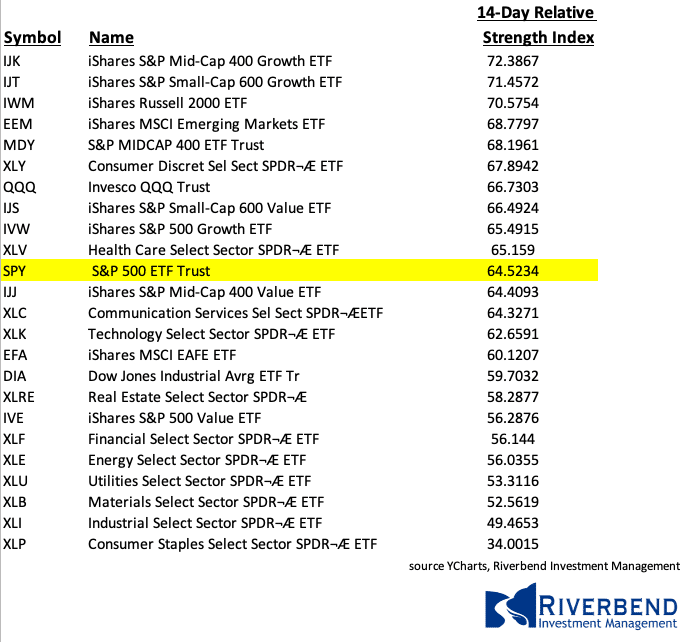
This leadership trend has been reflected in a strong, year to date performance over the S&P 500 as well:
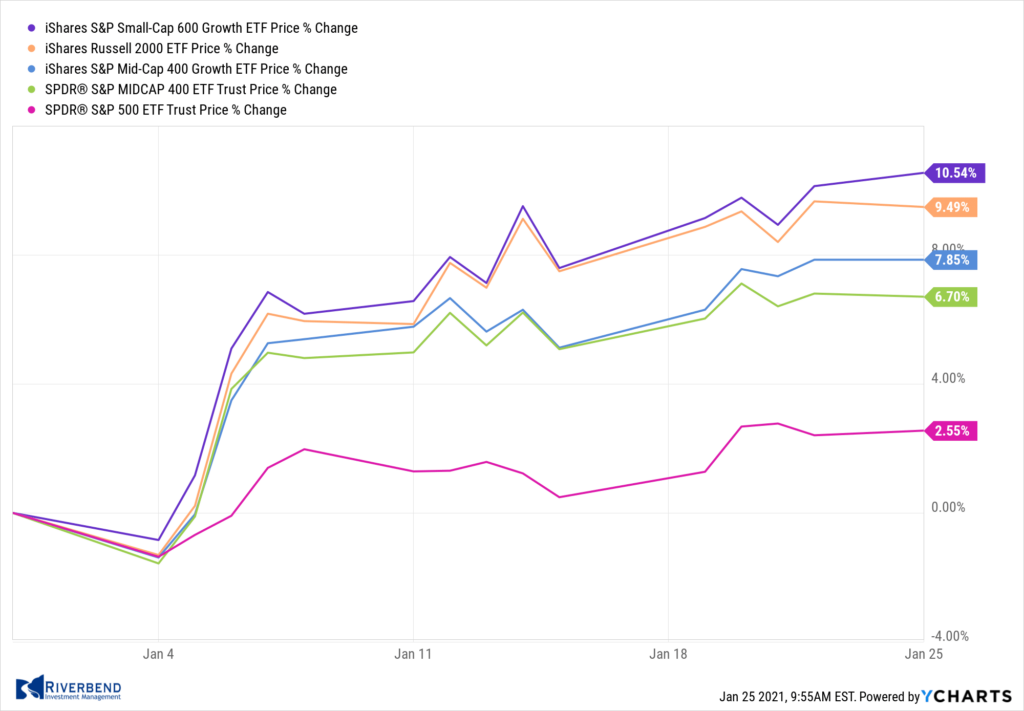
Currently, our investment models are still overweight the small and mid-cap areas of the market and continue to benefit from this theme. If/when this trend ends, our portfolios – which are adaptive in design – will reallocate accordingly. However, this may be the start of a multiyear trend — similar to what we saw occur after the 2000-2001 bear market:
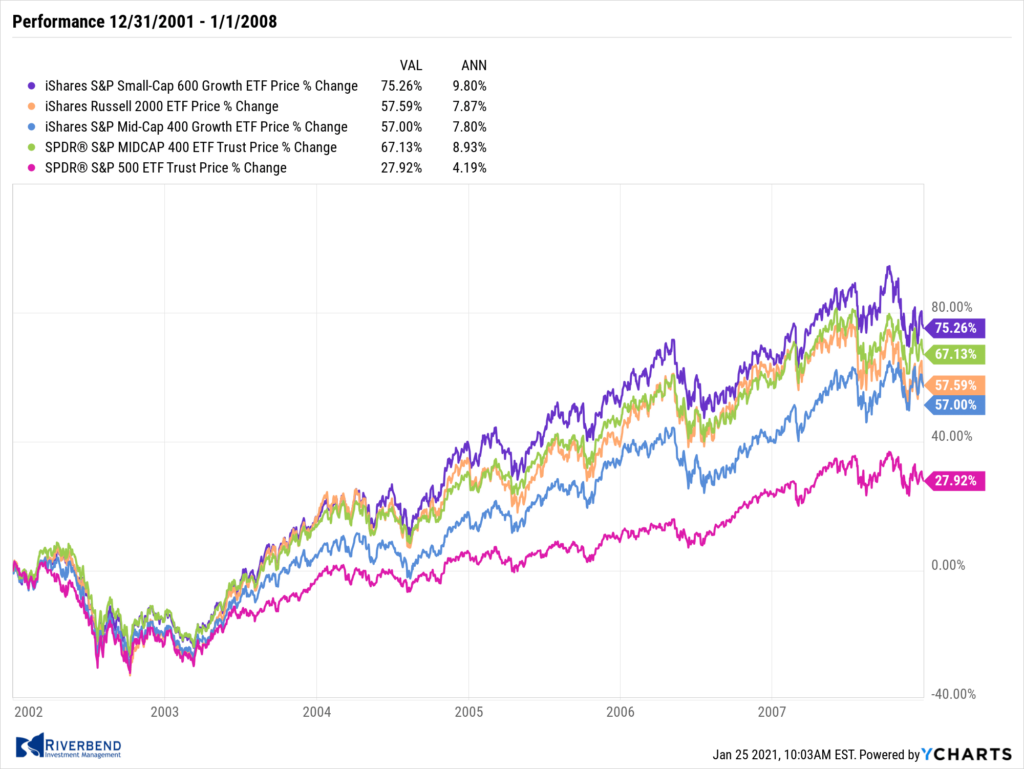
The Week Ahead:
Monday:
- German ifo Business Climate 91.5 exp, 92.1 prior
Tuesday:
- U.S. S&P/CS Composite-20 HPI y/y +8.3% exp, +7.9% prior
- U.S. CB Consumer Confidence 88.9 exp, 88.6 prior
- U.S. Richmond Manufacturing Index 22 exp, 19 prior
Wednesday:
- U.S. Durable Goods Orders m/m +1.0% exp, +1.0% prior
- U.S. Core Durable Goods Orders m/m +0.5% exp, +0.4% prior
- FOMC Monetary Policy Statement
Thursday:
- U.S. Advance GDP q/q +4.2% exp, +33.4% prior
- U.S. Unemployment Claims N/A exp, 900k prior
- U.S. Leading Index m/m 1.60 mln exp, 1.64 mln prior
- U.S. New Home Sales 860k exp, 841k prior
Friday:
- U.S. Personal Spending m/m -0.5% exp, -0.4% prior
- U.S. Pending Home Sales m/m -0.3% exp, -2.6% prior
- U.S. Chicago PMI 58.3 exp, 59.5 prior




